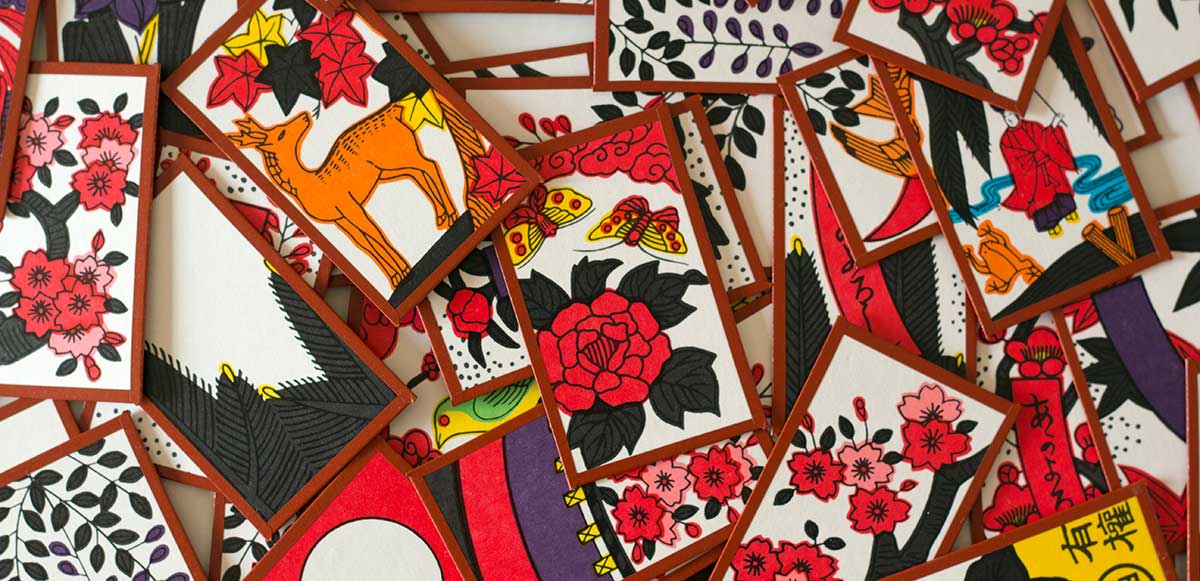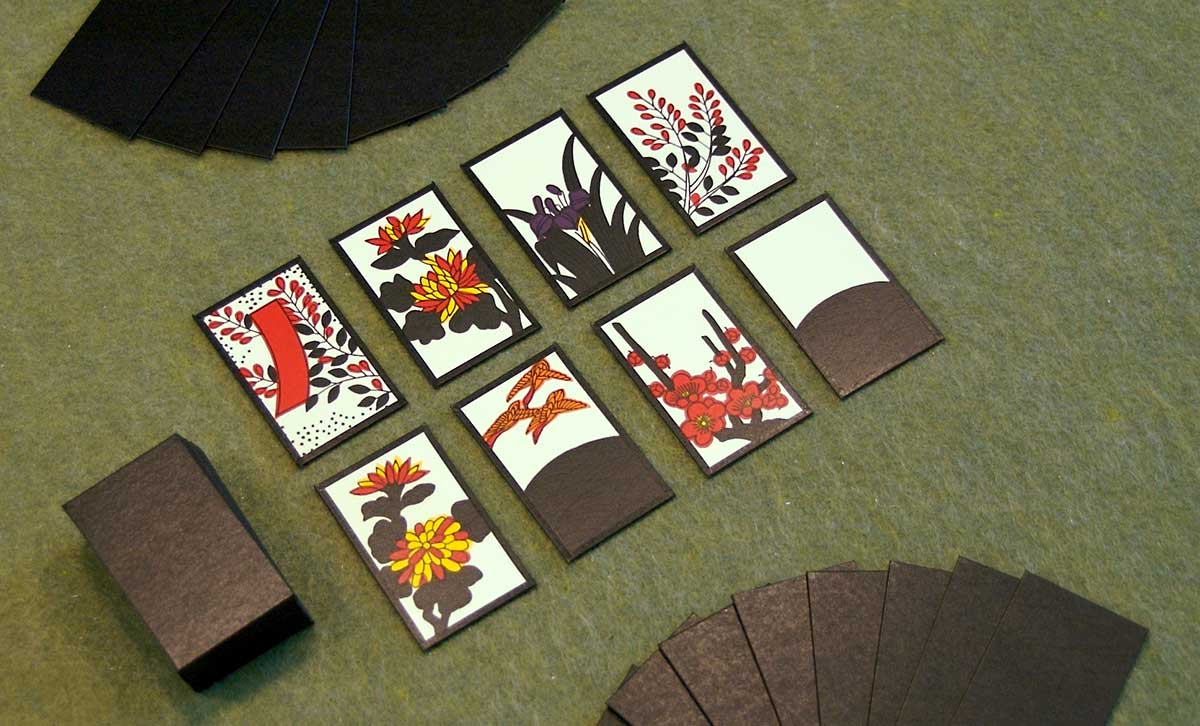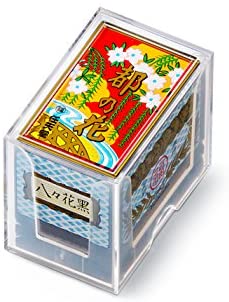
Hanafuda Beginner’s Guide & Cheat Sheet (Part 1: Sakura)
Learn the Sakura card game using Nintendo Hanafuda cards.

Table Of Contents
- Intro
- What Is Hanafuda?
- Hanafuda Card List
- How To Play Sakura
- Sakura Card Values
- Sakura Yaku
- Variation: Team Play
- Conclusion
Intro
While there are a lot of English resources online for how to play Hanafuda (Japanese Flower Cards), actually learning the game can be confusing. There are some great guides, but all of them seem to be missing something or other. Even the best guide I found, “A Definitive Guide to Koi-Koi” by Justin Gabriel, left us with questions while actually trying to play Hanafuda for the first time.
My goal for this guide is to present our own house rules in the most clear, unambiguous way possible. Our house rules were created by patching together a bunch of rules from incomplete guides out there while playing the game. They have been gameplay tested, so your first games of Hanafuda should be fun and balanced!
After you have your first few games down, you can start making your own house rules as you see fit. Although Koi-Koi is the most popular Hanafuda game, I will be teaching Sakura first, also known as Hawaiian-style Koi Koi. We’ve found that Sakura was easier to learn as a beginner, and therefore the best way to get familiar with the cards.
What Is Hanafuda?

Hanafuda, at its heart, is a covert set of gambling cards that were created in 1600s Japan to evade gambling bans:
In 1648, Tenshō Karuta were banned by the Tokugawa shogunate. During prohibition, gambling with cards remained highly popular which led to disguised card designs. Each time gambling with a card deck of a particular design became too popular, the government banned it, which then prompted the creation of a new design. This cat and mouse game between the government and rebellious gamblers resulted in the creation of increasingly abstract and minimalist regional patterns.

During the 1800s, Hanafuda would be banned in Japan, then be unbanned again as authorities realized that the bans were useless in curbing gambling. Finally in 1889, a craftsman named Fusajiro Yamauchi founded a company called Nintendo to mass-distribute Hanafuda cards. That’s the same Nintendo that went on to develop Super Mario, Donkey Kong, and Legend of Zelda video games!
If you don’t already have a deck of Hanafuda, Nintendo is still printing them. Pick them up on Amazon in black or in red. (Unfortunately, Amazon is the only place I’ve found to import these at a decent price in the USA).
When you’ve got your cards in hand, open them up and take a look at the instruction sheet. It’s written in Japanese. Useless. Throw it out.
Hanafuda Card List
A deck of Hanafuda is made up of 12 flower suits (called “hiki”), with 4 cards in each suit. Every suit is a flower or plant that represents one month of the year. January is the Pine Tree, February is Plum Blossoms, March is Cherry Blossoms, etc..
Many of the cards have special names, and some belong to special categories such as “Animals” and “Brights”. Let’s take a moment to get familiar with the deck.
-
Pine
(January)-
“Crane”
(Bright) -
Poetry Ribbon
-
-
-
-
Plum Blossom
(February)-
“Bush Warbler”
(Animal) -
Poetry Ribbon
-
-
-
-
Cherry Blossom
(March)-
“Curtain”
(Bright) -
Poetry Ribbon
-
-
-
-
Wisteria
(April)-
“Cuckoo”
(Animal) -
Red Ribbon
-
-
-
-
Iris
(May)-
“Bridge”
(Animal) -
Red Ribbon
-
-
-
-
Peony
(June)-
“Butterflies”
(Animal) -
Blue Ribbon
-
-
-
-
Bush Clover
(July)-
“Boar”
(Animal) -
Red Ribbon
-
-
-
-
Susuki Grass
(August)-
“Full Moon”
(Bright) -
“Geese”
(Animal) -
-
-
-
Chrysanthemum
(September)-
“Sake Cup”
(Animal) -
Blue Ribbon
-
-
-
-
Maple
(October)-
“Deer”
(Animal) -
Blue Ribbon
-
-
-
-
Willow
(November)-
“Rain Man”
(Bright) -
“Swallow”
(Animal) -
Red Ribbon
-
“Lightning Storm”
-
-
Paulownia
(December)-
“Chinese Phoenix”
(Bright) -
“Yellow Paulownia”
-
-
-
How To Play Sakura
Sakura, also known as Hawaiian-style Koi-Koi or Higo-Bana, can be played with individual players or between teams with two to seven people. I recommend playing without yaku (bonus card combinations) your first couple games. Then, once you’re comfortable playing without them, you can add them in.
Objective
Match cards by suit to collect them. Collect lots of high-point-value cards to win!
Determining The Dealer
To determine the dealer, or “oya”, each player draws one card at random from the deck. The player who drew the card of the earliest month of the year is the dealer.
Dealing Cards
Shuffle and deal cards face down to each player and face up to the middle of the table (the “field”). Use the following chart to determine how many cards to deal based on the number of players in the game:
| Number of players | Cards in hand | Cards face up |
|---|---|---|
| 2 | 8 | 8 |
| 3 | 7 | 6 |
| 4 | 5 | 8 |
| 5 | 4 | 8 |
| 6 | 3 | 12 |
| 7 | 3 | 6 |
Gameplay
In Sakura, the dealer always goes first. Then, play goes clockwise (this is our own house rule, opposite the traditional direction of play).
On your turn
-
Play a card from your hand into the field. If the suit of your card matches the suit of a card in the field, capture both cards by removing them from the field. If you captured cards in this way, place any captured cards with point-value face up in front of you in a “points section”, and place any captured zero-point-value cards into the discard pile.
-
Flip over a card from the deck into the field. Again, if the suit matches, capture both cards. Again if you captured cards in this way, place the ones with point-value in front of you and discard any that are of zero point value.
Example: It is the beginning of Miku’s turn. First, she starts with the “play” phase. She notices that unfortunately none of the cards in her hand match the suit of any of the cards in the field. She still must play a card from her hand into the field, but she does not get to capture anything during this phase of her turn - the card she played becomes part of the field. Now it is the second phase of Miku’s turn: the “flip” phase. Miku flips a card over from the top of the deck. Luckily for her, the suit of the card she flipped does match the suit of one of the cards out in the field. She captures both cards. Using the card points chart further down in this article, she realizes that one of the cards is worth 10 points and the other card is worth 0 points. She discards the 0-point card, and places the 10-point card face-up in front of her in her points section.
Wildcard Rule
Whenever a player plays or flips over the Lightning Storm ("Gaji") card, that player may match it with any other card in the field. Capture both cards and place the Lighting Storm card on top of the other captured card in your points section, even if it's a zero point card. (After play ends, the owner of the Lightning Storm will get to capture any cards left on the field that match the suit of the card captured by the Lightning Storm.)
Note: If the Lightning Storm card is dealt to the field during the initial deal, it is no longer wild, acting like a plain November card instead.
Hiki Rules
-
At any point during gameplay, if any player has sight of all four cards of a suit (e.g. they have 3 in their hand and 1 is in the field, 2 in hand and 2 in the field, 1 in hand and 3 in the field, or 4 in hand), that player may call “hiki” and immediately capture all four cards for themself.
-
If four cards of the same suit are dealt into the field at the beginning of the game, the dealer captures all four cards.
-
If there are three cards of the same suit in the field and a player turns over the fourth matching card from the deck, that player captures all four cards at once.
-
A player cannot call hiki to interrupt another player about to match a card, unless that card is the Lightning Storm wildcard. In that case, the player with the hiki must interrupt the lightning storm and capture the hiki. The other player may then use their Lightning Storm card to capture a different card in the field.
Ending The Round
Play ends immediately when every player runs out of cards in their hand. (If it’s your turn and you don’t have any cards in your hand, skip the first part of your turn and go directly to the part where you flip a card from the deck. Likewise, if there are no cards left in the deck, skip the deck-flipping part of your turn.)
Scoring
After the round ends, tally up the score using pencil and paper:
-
If a player captured the Lightning Storm card during the game, they capture any remaining cards in the field with the same suit as the card captured by the Lightning Storm.
-
Each player counts up the point total of the cards in front of them and adds it to their score.
-
If you are playing with yaku (bonus card combinations), then each player subtracts 50 points from their score for every yaku that an opponent made. For example if Player 1 scored 1 yaku and Player 2 scored 2 yaku, then Player 3 would deduct 150 points. Note: One card can score towards multiple yaku at the same time. Players can earn negative points for a round, and their score totals can go negative.
Full-Length Game
A full-length game of Sakura consists of twelve rounds. The winner of the last round deals the next round. In the case of a tie, the dealer of the last round deals the next round (“dealer’s privilege”).
If you don’t have time for a full game, consider playing a half-length game for a total of six rounds. Total up your points at the end of the game. The person with the most points wins.
Sakura Card Values
In Sakura, every card has a point value. At the end of a round, the point values of all the cards you’ve captured that round are added to your score. Below is a list of the point values of each card.
Sakura Yaku
Once you are familiar with playing the card game just to score cards by point value, you can add bonus card combinations called yaku to the play. Yaku are scored at the end of the round. For every yaku an opponent has made, subtract 50 points from your score. One card can count toward multiple yaku at the same time.
-
Yaku 1
(Curtain, Moon, Sake) -
Yaku 2
(Crane, Warbler, Curtain) -
Yaku 3
(Poetry Ribbons) -
Yaku 4
(Blue Ribbons) -
Yaku 5
(Butterflies, Sake, Deer) -
Yaku 6
(Red Ribbons, excluding Willow) -
Yaku 7
(Cuckoo, Bridge, Boar) -
Yaku 8
(Boar, Geese, Deer)
Variation: Team Play
To make it easier to score yaku, players split into two or three equal teams. Players on each team will combine their cards at the end of the round, scoring points and yaku across all of their team’s captured cards.
Conclusion
My family and I have been having a lot of fun playing Hanafuda. I hope that by making this guide, I’ve saved you the trouble of having to piece together a bunch of resources to learn how to play this game!
If you have any questions, please ask them in the comments section below. I would be happy to answer them, and it could help me improve this guide for future readers.
Next post in the series will be about how to play traditional Japanese-style Koi-Koi, which is slightly harder to learn but is built around an exciting double-or-nothing opportunity (the “Koi-Koi”) at the end of every round.
See you next time!
Image Credits:
Hanafuda Card Pile by Japanexperterna.se
More Articles Tagged #gaming
-

The Quiet Meditation of Getting Over It
22 July 2020 gaming personal -

Rest in Peace, Tribes Ascend
31 October 2018 gaming personal -

Gaming on YouTube: How To Get Popular, Get Partnered, and Get on Machinima.
03 August 2011 gaming personal tutorial















































